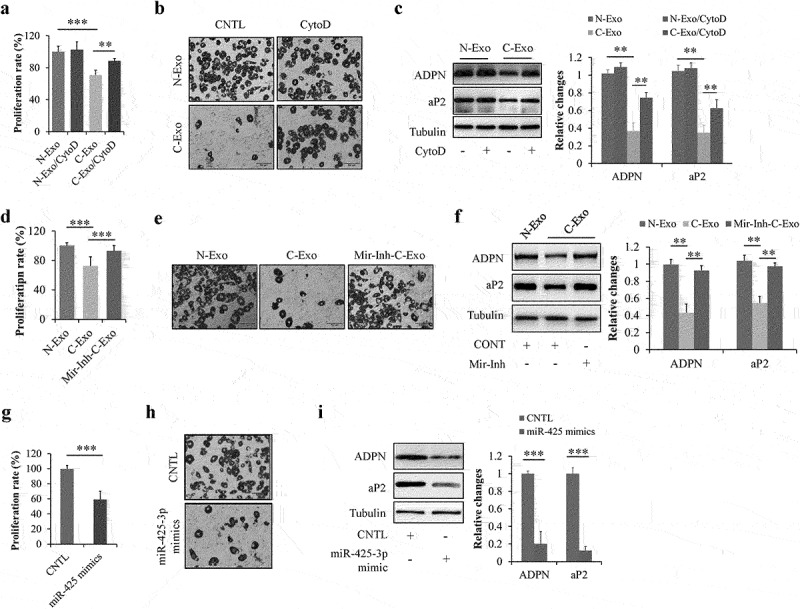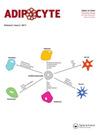癌细胞来源的外泌体miR-425-3p诱导白色脂肪细胞萎缩。
摘要
白色脂肪组织消耗在癌症恶病质的发生和发展中起着关键作用。然而,脂肪组织损失背后的机制仍然不清楚。在这项研究中,我们发现癌细胞来源的外泌体高度表达miR-425-3p。癌细胞来源的外泌体显著抑制人前脂肪细胞-黏稠(HPA-v)细胞的增殖和分化。在成熟脂肪细胞中,癌细胞来源的外泌体激活cAMP/PKA信号和脂质吞噬,导致脂肪细胞脂质分解和白色脂肪细胞褐化。这些外泌体诱导的改变几乎被内吞噬抑制剂细胞松弛素D (cytochalasin D, CytoD)和antagomiR-425-3p所消除,或者被miR-425-3p模拟物所复制。此外,生物信息学分析和荧光素酶报告基因检测显示,miR-425-3p直接靶向增殖相关基因,如GATA2、IGFBP4、MMP15、分化相关基因CEBPA和磷酸二酯酶4B基因(PDE4B)。PDE4B的缺失增强了cAMP/PKA信号传导和脂质吞噬,但对HPA-v的增殖和分化没有影响。综上所述,这些结果表明,癌细胞来源的外泌体miR-425-3p抑制前脂肪细胞的增殖和分化,增加脂肪细胞的脂解,促进白色脂肪细胞的褐变,所有这些都可能导致脂肪细胞萎缩,最终导致癌症恶恶质中脂肪组织的损失。ADPN:脂联素;aP2:脂肪细胞蛋白2或脂肪酸结合蛋白4 (FABP4);BCA:双醌酸测定法;BFA:巴菲霉素A1;BMI:身体质量指数;C/EBP: CCAAT/增强子结合蛋白;CEBPA: CCAAT/增强子结合蛋白;C-Exo:癌细胞来源的外泌体;CNTL:控制;CREB: camp反应元件结合蛋白;CytoD:细胞松弛素D;发射极耦合逻辑:化学发光;GATA2: GATA结合蛋白2;HFD:高脂肪饮食;HSL:激素敏感脂肪酶;IGFBP4:胰岛素样生长因子结合蛋白4;IRS-1:胰岛素受体底物-1;ISO:盐酸异丙肾上腺素;KD:击倒;KO:击倒;LC3:微管相关蛋白1A/ 1b -轻链3;LMF:脂质动员因子;脂蛋白脂肪酶;MMP15:基质金属肽酶15;Mir-Inh-C-Exo:具有miR-425-3p抑制的癌细胞来源的外泌体mTOR:哺乳动物雷帕霉素靶蛋白;傻瓜:突变;N-Exo:正常细胞来源的外泌体;NSCLC:非小细胞肺癌;PBS,磷酸盐缓冲盐水;PGC-1:过氧化物酶体增殖物激活受体- γ辅激活因子-1;pde:磷酸二酯酶;PKI: PKA抑制剂;camp依赖性蛋白激酶;PLIN1: Perilipin 1;PTHRP:甲状旁腺激素相关蛋白;PVDF:聚偏二氟乙烯;shRNA:短发夹RNA;UCP1:解偶联蛋白1;WT:野生型。



White adipose tissue wasting plays a critical role in the development and progression of cancer cachexia. However, the mechanism behind the loss of adipose tissue remains ill-defined. In this study, we found that cancer cell-derived exosomes highly expressed miR-425-3p. Administration of cancer cell-derived exosomes significantly inhibited proliferation and differentiation of human preadipocytes-viscereal (HPA-v) cells. In mature adipocytes, cancer cell-derived exosomes activated cAMP/PKA signalling and lipophagy, leading to adipocyte lipolysis and browning of white adipocytes. These exosomes-induced alterations were almost abolished by endocytosis inhibitor cytochalasin D (CytoD) and antagomiR-425-3p, or reproduced by miR-425-3p mimics. In addition, bioinformatics analysis and luciferase reporter assay revealed that miR-425-3p directly targeted proliferation-related genes such as GATA2, IGFBP4, MMP15, differentiation-related gene CEBPA, and phosphodiesterase 4B gene (PDE4B). Depletion of PDE4B enhanced cAMP/PKA signalling and lipophagy, but had no effects on HPA-v proliferation and differentiation. Taken together, these results suggested that cancer cell-derived exosomal miR-425-3p inhibited preadipocyte proliferation and differentiation, increased adipocyte lipolysis, and promoted browning of white adipocytes, all of which might contribute to adipocyte atrophy and ultimately the loss of adipose tissue in cancer cachexia.Abbreviations: ADPN: adiponectin; aP2: adipocyte protein 2 or fatty acid binding protein 4 (FABP4); BCA: bicinchoninic acid assay; BFA: bafilomycin A1; BMI: body mass index; C/EBP: CCAAT/enhancer binding protein; CEBPA: CCAAT/enhancer-binding protein-alpha; C-Exo: cancer cell-derived exosomes; CNTL: control; CREB: cAMP-response element binding protein; CytoD: cytochalasin D; ECL: chemiluminescence; GATA2: GATA Binding Protein 2; HFD: high fat diet; HSL: hormone-sensitive lipase; IGFBP4: insulin like growth factor binding protein 4; IRS-1: insulin receptor substrate-1; ISO: isoproterenol hydrochloride; KD: knockdown; KO: knock out; LC3: microtubule-associated protein 1A/1B-light chain 3; LMF: lipid mobilizing factor; LPL: lipoprotein lipase; MMP15: matrix metallopeptidase 15; Mir-Inh-C-Exo: cancer cell-derived exosomes with miR-425-3p inhibition; mTOR: mammalian target of rapamycin; Mut: mutant; N-Exo: normal cell-derived exosomes; NSCLC: non-small cell lung cancer; PBS, phosphate buffered saline; PGC-1: peroxisome proliferator-activated receptor-gamma coactivator-1; PDEs: phosphodiesterases; PKI: PKA inhibitor; PKA: cAMP-dependent protein kinase; PLIN1: Perilipin 1; PTHRP: parathyroid hormone-related protein; PVDF: polyvinylidene difluoride; shRNA: short hairpin RNA; UCP1: uncoupling protein 1; WT: wild type.

 求助内容:
求助内容: 应助结果提醒方式:
应助结果提醒方式:


